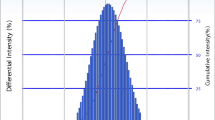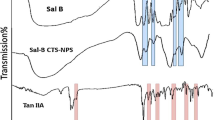Abstract
The current study aimed to fabricate nisin-loaded chitosan (N-CS) nanoparticles through ionic interactions between positive amino groups of chitosan and negatively charged tripolyphosphate ions in the presence of nisin and to evaluate their efficacy against foodborne pathogens in orange juice. The synthesized nanoparticles were sphere-shaped and homogenous with an average size of 64.34 ± 2.1 and 147.93 ± 2.9 for chitosan and N-CS nanoparticles, respectively. The encapsulation efficiency of nisin into nanoparticles was 67.32 ± 0.63%. Both chitosan and N-CS nanoparticles showed greater stability, as indicated by a higher zeta potential value of + 49.3 and + 33.4 mV, respectively. The in vitro antibacterial activities of chitosan and N-CS nanoparticles were investigated against the Gram-positive bacteria Staphylococcus aureus and Listeria monocytogenes and the Gram-negative bacteria Escherichia coli O157:H7 and Salmonella Typhimurium. N-CS nanoparticles showed higher activity compared with chitosan nanoparticles. The highest reduction of microorganisms was recorded for S. aureus of 3.82 log CFU/ml and L. monocytogenes of 3.61 log CFU/ml. The antimicrobial activity of N-CS nanoparticles in orange juice for 48 h revealed higher activity compared with the control against all the tested strains. The highest microbial reduction was recorded for N-CS nanoparticles against S. aureus with a 3.84 log CFU/ml reduction. L. monocytogenes and E. coli 0157:H7 were reduced by 3.54 and 3.44 log CFU/ml, respectively. The results showed high potential for the N-CS nanoparticles to be used as potent antibacterial agents in food and other related areas.




Similar content being viewed by others
References
Akhtar S, Sarker MR, Hossain A (2014) Microbiological food safety: a dilemma of developing societies. Crit Rev Microbiol 40:348–359
Alishahi A (2014) Antibacterial effect of chitosan nanoparticle loaded with nisin for the prolonged effect. J Food Saf 34:111–118
Bergholz TM, Tang S, Wiedmann M, Boor KJ (2013) Nisin resistance of Listeria monocytogenes is increased by exposure to salt stress and is mediated via LiaR. Appl Environ Microbiol 79:5682–5688
Bhatia S, Bharti A (2015) Evaluating the antimicrobial activity of Nisin, Lysozyme and Ethylenediaminetetraacetate incorporated in starch based active food packaging film. J Food Sci Technol 52:3504–3512. https://doi.org/10.1007/s13197-014-1414-7
Breukink E, de Kruijff B (1999) The lantibiotic nisin, a special case or not? BBA-Biomembranes 1462:223–234
CDC (Centers for Disease Control and Prevention) (2017) Burden of foodborne illness: overview. https://www.cdc.gov/foodborneburden/estimates-overview.html. Accessed 8 Mar 2017
Danyluk M, Goodrich-Schneider R, Schneider K, Harris L, Worobo R (2012) Outbreaks of foodborne disease associated with fruit and vegetable juices, 1922–2010. EDIS Publication FSHN12-04. http://edis.ifas.ufl.edu/pdffiles/FS/FS18800.pdf. Accessed 10 Mar 2017
da Silva Malheiros P, Daroit DJ, Brandelli A (2010) Food applications of liposome-encapsulated antimicrobial peptides. Trends Food Sci Technol 21:284–292
De Carvalho A, Vanetti M, Mantovani H (2008) Bovicin HC5 reduces thermal resistance of Alicyclobacillus acidoterrestris in acidic mango pulp. J Appl Microbiol 104:1685–1691
de Oliveira Junior AA, de Araújo Couto HGS, Barbosa AAT, Carnelossi MAG, de Moura TR (2015) Stability, antimicrobial activity, and effect of nisin on the physico-chemical properties of fruit juices. Int J Food Microbiol 211:38–43
Deegan LH, Cotter PD, Hill C, Ross P (2006) Bacteriocins: biological tools for bio-preservation and shelf-life extension. Int Dairy J 16:1058–1071
Dorkoosh F, Verhoef J, Rafiee-Tehrani M, Borchard G, Junginger H (2002) Peroral drug delivery systems for peptides and proteins. STP Pharma Sci 12:213–221
Gan Q, Wang T, Cochrane C, McCarron P (2005) Modulation of surface charge, particle size and morphological properties of chitosan–TPP nanoparticles intended for gene delivery. Colloids Surf B 44:65–73
Goy RC, Britto Dd, Assis OB (2009) A review of the antimicrobial activity of chitosan. Polímeros 19:241–247
Goy RC, Morais STB, Assis OBG (2016) Evaluation of the antimicrobial activity of chitosan and its quaternized derivative on E. coli and S. aureus growth. Rev Bras Farmacogn 26:122–127
Grande MJ et al (2005) Control of Alicyclobacillus acidoterrestris in fruit juices by enterocin AS-48. Int J Food Microbiol 104:289–297
Hosseini SF, Rezaei M, Zandi M, Farahmandghavi F (2016) Development of bioactive fish gelatin/chitosan nanoparticles composite films with antimicrobial properties. Food Chem 194:1266–1274
Karam L, Jama C, Dhulster P, Chihib N-E (2013) Study of surface interactions between peptides, materials and bacteria for setting up antimicrobial surfaces and active food packaging. J Mater Environ Sci 4:798–821
Khan I, Oh D-H (2016) Integration of nisin into nanoparticles for application in foods. Innov Food Sci Emerg Technol 34:376–384
Khan I, Khan M, Umar MN, Oh D-H (2015) Nanobiotechnology and its applications in drug delivery system: a review. IET Nanobiotechnol 9:396–400
Khan I, Ullah S, Oh D-H (2016) Chitosan grafted monomethyl fumaric acid as a potential food preservative. Carbohydr Polym 152:87–96
Khan I, Tango CN, Miskeen S, Oh D-H (2017) Evaluation of nisin-loaded chitosan-monomethyl fumaric acid nanoparticles as a direct food additive. Carbohydr Polym. https://doi.org/10.1016/j.carbpol.2017.11.034
Komitopoulou E, Boziaris IS, Davies EA, Delves-Broughton J, Adams MR (1999) Alicyclobacillus acidoterrestris in fruit juices and its control by nisin. Int J Food Sci Technol 34:81–85
Liu H, Gao C (2009) Preparation and properties of ionically cross-linked chitosan nanoparticles. Polym Adv Technol 20:613–619
Mohammadpour Dounighi N, Eskandari R, Avadi M, Zolfagharian H, Mir Mohammad Sadeghi A, Rezayat M (2012) Preparation and in vitro characterization of chitosan nanoparticles containing Mesobuthus eupeus scorpion venom as an antigen delivery system. J Venom Anim Toxins Incl Trop Dis 18:44–52
Muhammed R, Junise V, Saraswathi P, Krishnan P, Dilip C (2010) Development and characterization of chitosan nanoparticles loaded with isoniazid for the treatment of tuberculosis. Res J Pharm Biol Chem Sci 1:383–390
Oikeh EI, Omoregie ES, Oviasogie FE, Oriakhi K (2016) Phytochemical, antimicrobial, and antioxidant activities of different citrus juice concentrates. Food Sci Nut 4:103–109
Pei J, Yue T, Yuan Y (2014) Control of Alicyclobacillus acidoterrestris in fruit juices by a newly discovered bacteriocin. World J Microbiol Biotechnol 30:855–863
Perez Pulido R, Grande Burgos MJ, Galvez A, Lucas Lopez R (2016) Application of bacteriophages in post-harvest control of human pathogenic and food spoiling bacteria. Crit Rev Biotechnol 36:851–861
Quintavalla S, Vicini L (2002) Antimicrobial food packaging in meat industry. Meat Sci 62:373–380
Reiners J, Lagedroste M, Ehlen K, Leusch S, Zaschke-Kriesche J, Smits SH (2017) The N-terminal region of nisin is important for the BceAB-Type ABC Transporter NsrFP from Streptococcus agalactiae COH1. Front Microbiol 8:1643
Tango CN, Khan I, Park YS, Oh DH (2016) Growth of Staphylococcus aureus in cooked ready-to-eat ground fish as affected by inoculum size and potassium sorbate as food preservative. LWT-Food Sci Technol 71:400–408
Tomotake H, Koga T, Yamato M, Kassu A, Ota F (2006) Antibacterial activity of citrus fruit juices against Vibrio species. J Nutr Sci Vitaminol 52:157–160
Zhao L-M, Shi L-E, Zhang Z-L, Chen J-M, Shi D-D, Yang J, Tang Z-X (2011) Preparation and application of chitosan nanoparticles and nanofibers. Braz J Chem Eng 28:353–362
Zohri M, Alavidjeh MS, Haririan I, Ardestani MS, Ebrahimi SES, Sani HT, Sadjadi SK (2010) A comparative study between the antibacterial effect of nisin and nisin-loaded chitosan/alginate nanoparticles on the growth of Staphylococcus aureus in raw and pasteurized milk samples. Probiotics Antimicrob Proteins 2:258–266
Acknowledgement
The current work is supported by BK21 Plus Program and partly supported by Kangwon National University in 2015.
Author information
Authors and Affiliations
Corresponding author
Rights and permissions
About this article
Cite this article
Lee, E.H., Khan, I. & Oh, DH. Evaluation of the efficacy of nisin-loaded chitosan nanoparticles against foodborne pathogens in orange juice. J Food Sci Technol 55, 1127–1133 (2018). https://doi.org/10.1007/s13197-017-3028-3
Revised:
Accepted:
Published:
Issue Date:
DOI: https://doi.org/10.1007/s13197-017-3028-3




